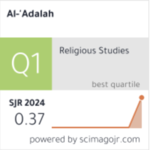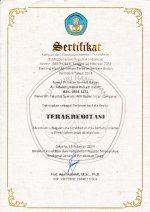The Role of Sharia Monetary Instrument in Liquidity Management and Performance Improvement of Islamic Banking Financial in Indonesia
Abstract
This study analyzes the variables of liquidity and financial performance of Islamic banks that affect the number of transactions in Islamic monetary instruments. The aim is to find out which instruments is better in supporting liquidity management and financial performance of Islamic banks in Indonesia. This study uses the CAR and FDR variables as proxies of liquidity and ROA as a proxy for the financial performance of Islamic banks. While the proxy for sharia monetary instruments in Indonesia is the variable SBIS and SBPUS. This study uses monthly Islamic banking reports in Indonesia for the period January 2015 to September 2017. Data is processed and analyzed by Augmented Dickey-Fuller (ADF) Stationery Test as a way of testing stationary data and then testing hypotheses using Vector Autoregression (VAR). This study found that the the most contributing variable to the changes in transaction volume in Islamic monetary instruments was the variable liquidity, namely CAR and FDR. In Addition, SBIS sharia monetary instruments are better used by Islamic banking in Indonesia compared to SBPUS.
Keywords
Full Text:
PDFReferences
Abdullah, D.V. Liquidity Management in Institutions Offering Islamic Financial Services. Paper Presented at The Second Islamic Financial Stability Forum, Jeddah, Kingdom of Saudi Arabia, 2010.
Adam, M.H.M. Evaluating The Financial Performance Of Banks Using Financial Ratios-Acase Study Of Erbil Bank For Investment And Finance. European Journal of Accounting Auditing and Finance Research 2, no. 6, (2014): 156-170.
Adwan, R. N. S. Risk Management In Islamic Banking. International Review of Management and Business Research 3, no. 4, (2014): 1855-1861.
Afiatun, P. & Wiryono, S.K. Efficiency and Productivity of Indonesian Islamic Banking. Jurnal Manajemen Teknologi 9, no. 3, (2010): 264-278.
Aggarwal & Yousef. Islamic Banks and Investment Financing. Journal of Money, Credit and Banking 32, no. 1, (2000): 93-120.
Al-Sayed. O. Money Market Instruments in Conventional and Islamic Banks. European International Journal of Science and Humanities 1, no. 3, (2015): 1-9.
Alshatti. The Effect of the Liquidity Management on Profitability in The Jordanian Commercial Banks. International Journal of Business and Management 10, no. 1, (2015): 62-71.
Andriansyah, Y. Kinerja Keuangan Perbankan Islam di Indonesia dan Kontribusinya bagi Pembangunan Nasional. Jurnal Ekonomi Islam La_Riba 3, no. 2, (2009): 181-196.
Anwar, D. Dampak Transaksi Instrumen Moneter Syariah terhadap Kinerja Perbankan Syariah di Indonesia. (Master Thesis), Universitas Indonesia, Jakarta, 2007.
Archer, S., Karim, R.A.A., & Sundarajan, V. Supervisory, Regulatory, and Capital Adequacy Implications of Profit-Sharing Investment Accounts in Islamic Finance. Journal of Islamic Accounting and Business Research 1, no. 1, (2010): 11-12.
Ariffin, N. M. Liquidity Risk Management And Financial Performance In Malaysia: Empirical Evidence From Islamic Banks. Aceh International Journal of Social Sciences 1, no. 2, (2012): 77-84.
Beck, T., Levine, R., & Loayza, N. Finance and the Sources of Growth. Journal of Financial Economics, 58, no. 1-2, (2000): 261-300.
Chapra, U. Sistem Moneter Islam. Jakarta: Gema Insani Press, 2000.
Chou. T., & Buchdadi. A.D. Bank Performance and Its Underlying Factors: A Study of Rural Banks in Indonesia. Accounting and Finance Research 5, no. 3, (2016): 55-63.
Deep. A. & Schaefer, G.K. Are Banks Liquidity Transformers? KSG Working Paper No. RWP04-022. (2004). Available at SSRN: http://ssrn.com/abstract=556289.
Diamond, D.W. Liquidity, Banks, and Markets: Effects of Financial Development on Banks and the Maturity of Financial Claims. World Bank Policy Research Working Paper No. 1566. (1996). Retrieved from SSRN: http://ssrn.com/abstract=615033.
Furqani, H. & Mulyany, R. Islamic Banking and Economic Growth: Empirical Evidence from Malaysia. Journal of Economic Cooperation and Development 30, no. 2, (2009): 59-74.
Ichsan, N. Pengelolaan Likuiditas Bank Syariah. Jurnal Al-Iqtishad 6, no. 1, (2014): 82-103.
Irsadunas. Analisis Terhadap Faktor-Faktor yang Mempengaruhi Posisi Outstanding SWBI. (Master Thesis) Universitas Indonesia, Jakarta, 2004.
Ismal, R. The Management Of Liquidity Risk In Islamic Banks: The Case Of Indonesia, Durham theses, Durham University. (2010). Available at Durham E-Theses Online: http://etheses.dur.ac.uk/550/.
Ismal, R. Central Bank Islamic Monetary Instruments: A Theoretical Approach. Studies in Economics and Finance 28, no. 1, (2011): 51-67.
Kasri, R.A. The Determinants of Islamic Banking Growth in Indonesia. Journal of Islamic Economics, Banking and Finance 3, no. 2, (2010): 41-64.
Khan, T. & Ahmed, H. Risk Management: An Analysis of Issues in Islamic Financial Industry. Occasional Papers, Jeddah: The Islamic Research and Teaching Institute (IRTI), 2001.
Kurniasih, Asih. Pengaruh Pembiayaan dan Transaksi Pasar Uang Antar Bank Syariah Terhadap Sertifikat Wadiah Bank Indonesia Tahun 2000-2004, (Master Thesis) Universitas Indonesia, Jakarta, 2005.
Laksono. B.G. Model Vector Auto Regressive, (Modul Kuliah) Universitas Indonesia, Jakarta, 2006.
Lartey, V.A & Boadi, E. The relationship between liquidity and profitability of listed banks in Ghana. International Journal of Business and Social Science, 4, no. 3, (2013): 48-56.
Leon, B.& Ericson, S. Manajemen Aktiva Pasiva Bank Non Devisa. Jakarta: PT. Grasindo, 2007.
Lori. G., Jafarey. S., & Padilla., F. Systemic Risk on The Interbank Market. London: Kings College Strand, 2004.
Muhammad. Lembaga-lembaga Keuangan Umat Kontemporer. Yogyakarta: UII Press, 2000.
Otoritas Jasa Keuangan. Transparansi dan Publikasi Laporan Bank Umum Islam dan Unit Usaha Islam (Lampiran Pedoman Surat Edaran Nomor 18/SEOJK.03/2015), Jakarta, 2015.
Pramuharjo, A. B. Analisis Pengaruh Kebijakan Moneter terhadap Deposito, Pembiayaan, dan Likuiditas Perbankan Syariah di Indonesia, (Master Thesis), Univeritas Indonesia, Jakarta, 2005.
Ramzan, M., & Zafar, I. Liquidity Risk Management in Islamic Banks: A Study of Islamic Banks of Pakistan. Interdisciplinary Journal of Contemporary Research in Business, 5, no. 12, (2014): 199-215.
Ruliana. T., Hariyadi. R.M. & Winarsih. S. Health Level Of Bank Using Risk Based Bank Rating. Scientific Papers Series Management, Economic Engineering in Agriculture and Rural Development 16, no. 1, (2016): 451-458.
Sandy, G.E. Pengaruh Liquiditas Dan Solvabilitas Terhadap Kinerja Keuangan Perbankan Indonesia Yang Terdaftar di Bursa Efek Indonesia Pada Tahun 2010 – 2012, Universitas Jember, Jember, 2015.
Sarker, A.A. An Evaluation of Islamic Monetary Policy Instruments Introduced in Some Selected OIC Member Countries. Islamic Economics Studies 24, no. 1, (2016): 1-47.
Siregar, M. Agenda Pengembangan Perbankan Islam Untuk Mendukung Sistem Ekonomi yang Sehat di Indonesia: Evaluasi, Prospek dan Arah Kebijakan. Iqtisad: Jurnal Ekonomi Islam 3, no. 1, (2002): 46-66.
Sulaiman, A.A., Mohamad, M.T., & Samsudin, M.L. How Islamic Banks of Malaysia Managing Liquidity? An Emphasis on Confronting Economic Cycles. International Journal of Business and Social Science 4, no. 7, (2013): 253-263.
Syukron, A. Dinamika Perkembangan Perbankan Islam di Indonesia. Economic: Jurnal Ekonomi dan Hukum Islam 3, no. 2, (2013): 28-35.
Tanuwidjaja, E. & Choy., K.M. Central Bank Credibility and Monetray Policy in Indonesia, Journal of Policy Modelling 28, (2006): 1011-1012.
Thantawi, T.R. Pengaruh Kebijakan Bonus SWBI dan Penjaminan Pemerintah Terhadap Tingkat Imbalan Pasar Uang Antar Bank Berdasarkan Prinsip Syariah di Indonesia. (Master Thesis) Univeristas Indonesia, Jakarta, 2005.
Utama, C. Mengukur Tingkat Kesehatan Bank di Indonesia. Jurnal Bina Ekonomi, 10, no. 1, (2006): 48-56.
Wagner, W. The Liquidity of Bank Assets and Banking Stability (2004). Retieved from SSRN: http://ssrn.com/abstract=556128 or http://dx.doi.org/10.2139/ssrn.556128
Widagdo., Kuncara, A., Ika. & Rochmah S. The Interest Prohibition and Financial Performance of Islamic Banks: Indonesian Evidence. International Business Research 1, no. 3, (2008): 98-109.
Wuryandani. G., Ginting. R., Iskandar. D., & Sitompul. Z. Perilaku Bank Dalam Penghimpunan dan Penempatan Dana: Implikasi Terhadap Likuiditas. Buletin Ekonomi Moneter dan Perbankan. Bank Indonesia, 2012.
DOI: http://dx.doi.org/10.24042/adalah.v15i2.3200
Refbacks
- There are currently no refbacks.
Copyright (c) 2019 AL-'ADALAH
Al-'Adalah is licensed under a Creative Commons Attribution-ShareAlike 4.0 International License.




.png)
_(1).png)
_(1).png)

.png)
